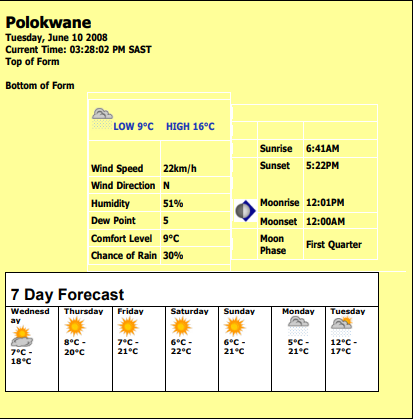Weather forecast is given on the radio, television and in the newspapers on a daily basis. If you have access to the internet you can get the forecast from the www.weatherforecast.co.za . You can even get the weather forecast on your cell phone by dialling 082162 and follow the prompts.
Progressive farmers have their own electronic weather station on the farm to provide them with the information needed for various activities such as:
- Production planning for the next season by using long term predictions. (When to plant what.)
- Use the medium-term predictions to plan planting dates
- Short term predictions – weekly- to plan the week‘s activities e.g., cutting of hay and the spraying of crops.
- Scheduling of irrigation is also a very important function where the weather stations and weather information play a very important role.
The South African weather service makes long, medium- and short-term predictions and the farmers should use this in their planning. Although the predictions may not be 100% accurate, it provides an indication of what to expect.
Producer’s organisations such as SA Grain and the ARC (Institute for Soil, Water and Climate) also provide long term predictions to their members to assist them with the planning. Many farmers keep their own records to give them an idea of what is happening on their own farm.
Weather information can also be obtained via the internet from the following websites www.graansa.co.za www.arc.gov.za www.weathersa.gov.za
Types of Forecast
The following is an example of the different types of forecasts that can be obtained from the SA Weather service.

Long Term Predictions
The weather activities in other parts of the world and the water temperature at the south sea can influence the weather patterns in South Africa, Southern Africa and Australia. Very important is El Niño and la Niño patterns in the Pacific Ocean. El Niño pattern causes dry conditions in South Africa whilst the La Niño pattern has the opposite effect on the weather. It is important that the farmer take note of the long-term predictions and also look at the weather patterns in his area. To observe what is happening in nature, the farmer will also obtain information that can assist in decision making.
Medium-term Predictions
Medium-term predictions will provide information concerning the present production season. Farmers normally use this information to determine planting dates, plant density, top dressing or not and suitable cultivars for the production season. (The SA. Weather service is constantly busy improving on their prediction techniques to provide better services to the public.)
Short Term
Short term forecasts are for a few days only, a maximum of a week. The forecast is normally made for three days or is given on a daily basis. This can be used to assist with activities such as harvesting, cutting of fodder and planting. The Weather Service also issued warnings regarding the possibility of veld fires, approaching cold spells (to protect animals) and strong winds. Different equipment can be used to predict and record weather patterns. Modern technology makes it possible for more accurate predictions. It is very important to record the weather on a daily basis. This can be used for later reference and to assist in the elimination of previous mistakes. (Some people observe the reaction of the insects, birds and wild animals to predict the weather.)
Accuracy
No one can predict the outcome of certain weather patterns with 100 % accuracy. The Weather service makes use of models to do their predictions and work on probabilities. The weather patterns are observed, and according to the previous experience and available information, the outcome is predicted. Patterns such as the influx of moist air from the tropical region can bring rain while a cold front moving over the country can cause rain in certain areas.
Use of Forecast
The forecast obtained from the SA Weather service or any other weather service can be used for the following purposes:
- Planting or cultivation of crops
- Cutting or mowing of pastures or fodder crops
- Spraying of crops before the rain to prevent the remedy from being washed from the plants
- Wind direction and strength are needed when you make fire breaks to prevent runaway fires
- Temperature - when to protect plants and animals against cold weather
- Scheduling of irrigation - using wind, temperature and evaporation to calculate the amount of water needed
- Harvesting of certain crops – fruit